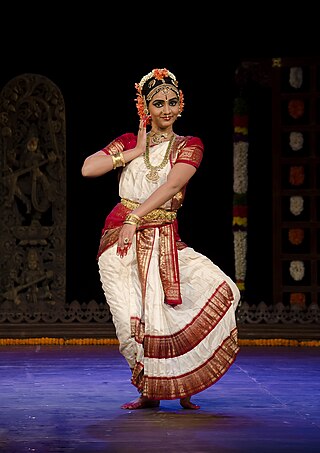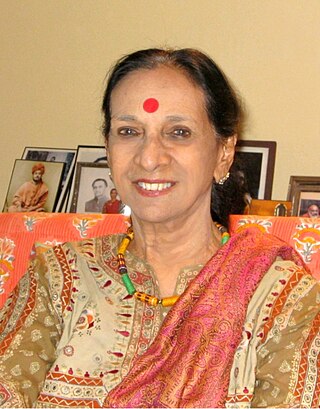Related Research Articles

Bharatanatyam is an Indian classical dance form that originated in Tamil Nadu. It is a classical dance form recognized by the Sangeet Natak Akademi, and expresses South Indian religious themes and spiritual ideas, particularly of Shaivism and in general of Hinduism.

Kalakshetra Foundation, formerly simply Kalakshetra, is an arts and cultural academy dedicated to the preservation of traditional values in Indian art and crafts, especially in the field of Bharatanatyam dance and Gandharvaveda music. Based in Chennai, India, the academy was founded in January 1936 by Rukmini Devi Arundale and her husband George Arundale. Under Arundale's guidance, the institution achieved national and international recognition for its unique style and perfectionism. In 1962, Kalakshetra moved to a new campus in Besant Nagar, Chennai, occupying 40 hectares of land.

Kuchipudi is one of the eight major Indian classical dances. It originates from a village named Kuchipudi in the Indian state of Andhra Pradesh. Kuchipudi is a dance-drama performance, with its roots in the ancient Hindu Sanskrit text of Natya Shastra. It developed as a religious art linked to traveling bards, temples and spiritual beliefs, like all major classical dances of India.

Chennai Music Season is an event hosted every Mid November–January in Chennai Tamil Nadu. Spanning some 9 weeks, it comprises top-flight professional and amateur musicians. The traditional role of the Music Season is to allow aficionados of Carnatic music to appreciate performances by renowned artists, and to allow promising young artists to display their talent and skill. Audiences and artists come from across India and her diaspora to enjoy the season.

Rukmini Devi Arundale was an Indian theosophist, dancer and choreographer of the Indian classical dance form of Bharatanatyam, and an activist for animal welfare.

Tanjore Balasaraswati, also known as Balasaraswati, was an Indian dancer, and her rendering of Bharatanatyam, a classical dance style originated in the South Indian state of Tamil Nadu, made this style of dancing well known in different parts of India and many parts of the world.

Sonal Mansingh is an Indian classical dancer and Guru in Bharatanatyam and Odissi dancing style. She has been nominated by the President of India to become a Member of Parliament, Rajya Sabha. She is the recipient of Padma Bhushan in 1992 and Padma Vibhushan in 2003.

Bala is a 1976 documentary film made by Satyajit Ray, about a Bharatanatyam dancer, Balasaraswati, fondly known as "Bala". The film was jointly produced by National Centre for the Performing Arts and Government of Tamil Nadu. The thirty-three-minute documentary features the life and some of the works by Balasaraswati in the form of narration and dance, starring herself. At the age of fourteen, Ray had seen a performance of Balasaraswati in Kolkata, then known as "Calcutta", in 1935, when she was seventeen years old.
Jon Borthwick Higgins, also known in India as Higgins Bhagavatar, was an American musician, scholar, and teacher known principally for his rare skill as a non-Indian in the field of Carnatic music.

Mrinalini Vikram Sarabhai was an Indian classical dancer, choreographer and instructor. She was the founder and director of the Darpana Academy of Performing Arts, an institute for imparting training in dance, drama, music and puppetry, in the city of Ahmedabad. She received Padma Bhushan in 1992 and Padma Shri in 1965. She also received many other citations in recognition of her contribution to art.
Tanjore Viswanathan was a Carnatic musician specializing in the Carnatic flute and voice.

The Kalaimamani is the highest civilian award in the state of Tamil Nadu, India. These awards are given by the Tamil Nadu Iyal Isai Nataka Mandram, a unit of the Directorate of Art and Culture, Government of Tamil Nadu, to recognise artists in the state for their achievements.
Adyar K. Lakshman was a noted Indian Bharatnatyam dancer, choreographer and guru.
V. K. Narayana Menon (1911–1997) was a scholar of classical Indian dance and Indian classical music. He was one of the prominent art critics of India and a Sangeet Natak Akademi Fellowship.
E. Krishna Iyer was an Indian lawyer, freedom-fighter, classical artist and activist. He was the follower of traditional Isaivellalar practitioners of Sadir, also known as Bharatanatyam.
Alarmel Valli is an Indian classical dancer and Bharatanatyam-Pandanallur choreographer.
Justin McCarthy is an American-born noted Indian Bharatnatyam dancer, instructor and choreographer. He teaches Bharatnatyam at the Shriram Bharatiya Kala Kendra at Delhi, where he has been for the last three decades. He moved to India in 1979, learnt Bharatanatyam from danseuse Leela Samson for ten years, before beginning to teach it at the Shriram Bharatiya Kala Kendra at Delhi, where he has teaching ever since. Prior to this he received his early training at the Dance School of Berkeley, and later trained under Subbaraya Pillai, a leading Guru of the Pandanallur style of Bharatanatyam at Chennai. He is also a pianist of Western classical music, and adept in Carnatic music.

Kalanidhi Narayanan was an Indian dancer and teacher of Indian classical dance form of Bharatnatyam, who was the early non-devadasi girl to learn the dance form and perform it on stage in the 1930s and 1940s. After a brief career in the 1940s, she returned to dance in 1973 and became a notable teacher of abhinaya.
Shanta Rao was a notable dancer from India. She studied and performed Kathakali, Bharatanatyam and Kuchipudi.

Geeta Chandran is an Indian Bharatanatyam dancer and vocalist. Trained in Carnatic music, she is a visionary and celebrated artist in Indian classical Bharatanatyam, recognized for her work in theatre, dance, education, videos and films.
References
- ↑ "19-year-old keeps alive his Indian dance heritage", The Herald-Sun Durham, NC - Sunday, July 2, 2000
- 1 2 Janani Sampath (11 September 2013). "To dance like a man". New Indian Express . Archived from the original on December 18, 2013. Retrieved November 14, 2013.
- 1 2 3 4 Jennifer Dunning (December 6, 2005). "DANCE REVIEW; A Family's Moves, Centuries Old". The New York Times . Retrieved November 17, 2013.
- ↑ Douglas M. Knight Jr., Balasaraswati: Her Art and Life, Wesleyan University Press (June, 2010) - Pages: xvii, 17,246,248-250,249.251.
- 1 2 3 Vibhuti Patel. "Dance, Indian Style", Newsweek , April 2008
- 1 2 Gowri Ramnarayan "It is not entertainment", The Hindu , August 28, 2009, 28th.
- ↑ Sandhya Kumar, "A Life That Was Art: The Dancer Balasaraswati", AsiaSociety.org, June 24, 2010.
- ↑ Sujata Srinivasan, "Heir to a Weighty Legacy" [ permanent dead link ], CT Indian Legacy, March 2008, Vol: 2, No: 3.
- ↑ "Daylight's Children", Newsweek , August 1997.
- ↑ Gowri Ramnarayan "Throwing light on a magnificent tradition", The Hindu , Dec 15, 2006.
- ↑ "National Endowment for the Arts - Annual Report 2005", page 64.
- ↑ "New England Foundation for the Arts - Annual Report 2007" Archived 2012-04-16 at the Wayback Machine , page 20
- ↑ ""Faculty Publications, Grants, and Awards - Bates 2010-11"" (PDF). Archived from the original (PDF) on 2014-01-14. Retrieved 2013-02-22.
- ↑ ""New England Foundation for the Arts - Annual Report 2011"" (PDF). Archived from the original (PDF) on 2012-04-16. Retrieved 2013-02-22.